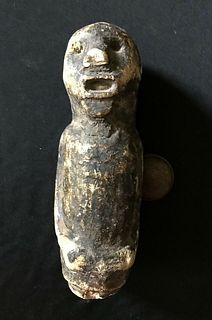6th C. Early Medieval / Late British Celtic Stone Head
Lot 26
About Seller
Artemis Gallery
686 S Taylor Ave, Ste 106
Louisville, CO 80027
United States
Selling antiquities, ancient and ethnographic art online since 1993, Artemis Gallery specializes in Classical Antiquities (Egyptian, Greek, Roman, Near Eastern), Asian, Pre-Columbian, African / Tribal / Oceanographic art. Our extensive inventory includes pottery, stone, metal, wood, glass and textil...Read more
Estimate:
$3,000 - $4,500
Absentee vs Live bid
Two ways to bid:
- Leave a max absentee bid and the platform will bid on your behalf up to your maximum bid during the live auction.
- Bid live during the auction and your bids will be submitted real-time to the auctioneer.
Bid Increments
| Price | Bid Increment |
|---|---|
| $0 | $25 |
| $300 | $50 |
| $1,000 | $100 |
| $2,000 | $250 |
| $5,000 | $500 |
| $10,000 | $1,000 |
| $20,000 | $2,500 |
| $50,000 | $5,000 |
| $100,000 | $10,000 |
| $200,000 | $20,000 |
About Auction
By Artemis Gallery
Jan 7, 2021
Set Reminder
2021-01-07 10:00:00
2021-01-07 10:00:00
America/New_York
Bidsquare
Bidsquare : Ancient / Ethnographic Art Through The Ages
https://www.bidsquare.com/auctions/artemis-gallery/ancient-ethnographic-art-through-the-ages-6258
Ancient art from Egypt, Greece, Italy and the Near East, as well as Asian, Fossils, Pre-Columbian, Native American, African / Tribal / Oceanic, Fine art, and much more! All categories, all price ranges... all legally acquired and guaranteed to be as described or your money back. Artemis Gallery info@artemisgallery.com
Ancient art from Egypt, Greece, Italy and the Near East, as well as Asian, Fossils, Pre-Columbian, Native American, African / Tribal / Oceanic, Fine art, and much more! All categories, all price ranges... all legally acquired and guaranteed to be as described or your money back. Artemis Gallery info@artemisgallery.com
- Lot Description
Early Medieval / late British Celtic, ca. 6th to 10th century CE. A skillfully carved stone bust presenting a dramatic visage comprised of large almond-shaped eyes, an arched browline, an aquiline nose, pursed lips, a cleft chin, and a full head of hair - with the neck rising from a columnar base. Earlier yet similar Gallo-Roman forms have been interpreted as representations of pilgrims worshipping or honoring the Gallo-Roman goddess Sequana. Perhaps those forms served as inspiration for this busts like this example. Size: 7" W x 11.5" H (17.8 cm x 29.2 cm)
A bust of a similar form was found among the votive offerings found at the site of a temple complex at the source of the Seine River in Dijon, France that included a statue of Sequana created some 2,000 years ago. According to scholar Elaine Sciolino, "A fictionalized 18th-century story about Sequana turned her into a proto-feminist survivor who escaped the clutches of a lascivious Neptune by transforming herself into the Seine River. (The Seine was initially called Sequana.) The story is woven into the ancient Greek myth of Persephone, who succumbed to Hades and had to spend much of her life trapped in the underworld. Unlike Persephone, who fell victim to her abductor, Sequana escaped." (Elaine Sciolino, "In Dijon, Where Mustard Rules, You Can Also Meet an Ancient Goddess" New York Times, October 5, 2019)
Provenance: private Coral Gables, Florida, USA collection; ex-private Burgundy, France collection, acquired from a Paris auction house in the 1960s
All items legal to buy/sell under U.S. Statute covering cultural patrimony Code 2600, CHAPTER 14, and are guaranteed to be as described or your money back.
A Certificate of Authenticity will accompany all winning bids.
We ship worldwide and handle all shipping in-house for your convenience.
#161002Surface with wear as shown. No repairs or restoration and a fine early example.Condition
- Shipping Info
-
All shipping is handled in-house for your convenience. Your invoice from Artemis Gallery will include shipping calculation instructions. If in doubt, please inquire BEFORE bidding for estimated shipping costs for individual items.
-
- Buyer's Premium



 EUR
EUR CAD
CAD AUD
AUD GBP
GBP MXN
MXN HKD
HKD CNY
CNY MYR
MYR SEK
SEK SGD
SGD CHF
CHF THB
THB















